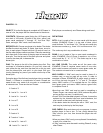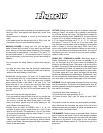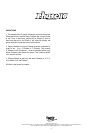
2
INSTRUCTIONS
3
INSTRUCTIONS
•A “Skip” card may never be picked up from the discard pile.
•Only one “Skip” card against each player per “round” may
be used.
•When someone is skipped, a “round” is once around the
table.
•If the dealer starts the discard pile with a “Skip” card, the
rst player’s rst turn is automatically skipped.
MAKING A PHASE: If, during your turn, you are able to
make a Phase with the cards in your hand, lay the Phase
down, face-up on the table before discarding. For example,
you are trying to make Phase 1. You have 3 “5s” and 2 “7s”
and you draw another “7.” You now have 2 sets of 3, and you
may lay them down. In the next hand, you will be working on
Phase 2.
•You must have the whole Phase in hand before laying it
down.
•You may lay down more than the minimum requirements
of a Phase, but only if the additional cards can be directly
added to the cards already in the Phase.
EXAMPLES: You lay down 3 “5s” and 3 “7s” to make Phase
1. You have two more “5s” in hand and can immediately lay
them down with the 3 ”5s,” all in the same turn. Another
player making Phase 1 lays down 3 “6s” and 3 “8s.” The
player also has 3 “10s” in hand, but cannot lay them down
because Phase 1 requires exactly 2 sets. Thus, the player
can only add more “6s” and “8s” to the Phase made of “6s”
and “8s.”
•Only one Phase can be made per hand.
•If you successfully make a Phase, then you try to make the
next Phase in the next hand. If you fail to make a Phase,
you must try to make the same Phase again in the next
hand. As a result, players may not all be working on the
same Phase in the same hand.
•Phases must be made IN ORDER, from 1 to 10. For
example, a player trying to make Phase 4 (1 run of 7) lays
down a run of 9 cards. This qualies as 1 run of 7 for Phase
4, but cannot be used as credit for either Phase 5 (1 run of
8) or Phase 6 (1 run of 9).
•You receive credit for making a Phase as soon as you lay
it down. You do not need to win the hand in order to receive
credit for the Phase. Several players will often complete a
Phase in the same hand.
HITTING: Hitting is the way to get rid of leftover cards after
making a Phase. You make a hit by putting a card directly
on a Phase already laid down. The card must properly t
with the cards already down. EXAMPLES: You may add one
or more “4s” to a player’s existing set of “4s.” You may add
a “2” to a player’s existing run of “3,” “4,” “5,” “6.” You may
also add a “7” and an “8” to this run, if you have them. You
may add one or more green cards to a player’s seven green
cards in Phase 8. You may also add a “Wild” card of any
color to any of these card situations. Before you can make a
hit, your own Phase must already be laid down. You may hit
only during your turn. You may hit your own cards, another
player’s cards, or both.
GOING OUT / FINISHING A HAND: After laying down a
Phase, players try to “go out” as soon as possible. To go
out, you must get rid of all of your cards, by discarding or
hitting on an existing Phase. The player to go out rst wins
the hand. The winner of the hand, and any other players who
also complete their Phase, will advance to the next Phase
for the next hand. Players total the cards left in their hands.
(The fewer cards left in your hand, the better!) All the cards
are then shufed and a new hand begins. (Remember, if you
did not complete the Phase before another player went out,
you must work on the same Phase again in the next hand.)
SCORING: You will need paper and pencil to keep a running
total for each player. The winner of the hand scores zero. All
remaining players score points against them, for cards still in
their hands, as follows:
•5 points for each card numbered 1-9
•10 points for each card numbered 10-12
•15 points for each “Skip” card •25 points for each “Wild”
card
Only cards in hand are scored, not cards already laid down.
After the scores are recorded, the player to the left of the
dealer becomes the new dealer. All cards are gathered and
shufed, and a new hand is dealt.
THE WINNER: The rst player to complete Phase 10 at the
end of a hand is the winner. If two or more players complete
Phase 10 in the same hand, then the player with the fewest
total points is the winner. In the event of a tie, the players
that tied replay Phase number 10. The rst one to go out is
the winner.





